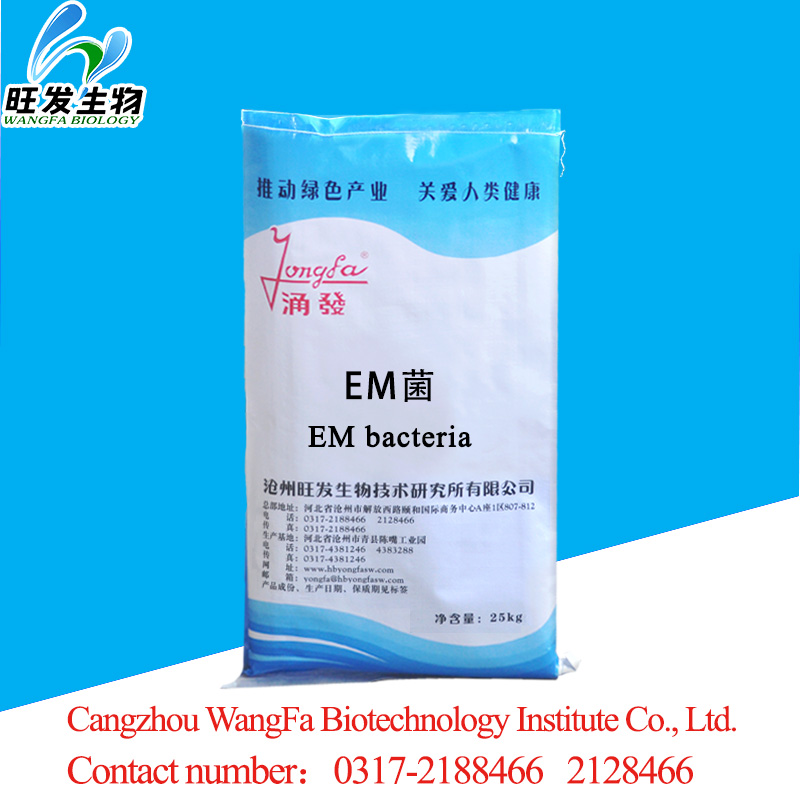
Agricultural EM bacteria
A variety of beneficial microbes, including aerobic bacteria and anaerobes, are integrated together through unique fermentation techniques, among which each microorganism grows together in the process of proliferation, forming a powerful whole, giving full play to many aspects such as "beneficial decomposition" and "antioxidant". The role.
[application] all kinds of crops, vegetables, fruits, herbs, flowers, seedlings, organic manure fermentation, etc., suitable for the production of organic, green, harmless food.
[character] powder / light yellow liquid
[main functions]
1, enhance the metabolism of plants, promote photosynthesis and strengthen leaf protection membrane, promote the development of the root system, improve the capacity of nutrient absorption, increase crop yield and improve the quality of crops.
2. Symbiotic co culture with actinomycetes in soil to improve soil fertility. Inhibit pathogenic microorganisms, prevent and reduce diseases and insect pests, and reduce continuous cropping obstacles.
3, to promote soil granulation, water and air permeability, eliminate soil hardening. Promote the decomposition of soil organic matter, make it more easily absorbed by plants, decompose fertilizer and pesticide residues, improve the quality and achieve green pollution-free standards.
4, synthetic amino acids, carbohydrates, vitamins, etc., to promote germination, growth, flowering and maturity of crops.
5, low cost and high return, the effect of using many kinds of crops is remarkable. Such as melon and fruit, single fruit weight gain, sugar content increased, fruit preservation rate increased.
[usage and dosage]
Powder: 1, seed mixing: the amount of 300-500 grams per mu, wet the seeds and mixed with the bacteria, with each seed stick to the appropriate, overcast for 8-12 hours to sow. 2, hole application: 1000-2000 grams per mu, used for apple, pear tree, grape, jujube, peach, seedling and so on. When applied, 4-6 soil acupoints or ring trenches are dug under the crown of the fruit tree. The depth is seen in the fibrous root, sprinkled with the fungus, and the water is covered with soil. Pepper, tomato, Chinese herbal medicine, flowers and so on, when the seedlings are transplanted, put the bacteria agent on the lower part of the cultivation hole and then plant it. 3, dip root: the amount of 500-1000 grams of mu, suitable for seedling transplanting crops, the bacteria and fine soil in the proportion of 1:1 mix, mixed with a small amount of water into a paste, after the root of transplanting.
4, spreading: the amount of 1000-2000 grams of mu, the greenhouse vegetables and field applications, the bacteria and fine soil in the ratio of 1:1 mixed after the application, and then ploughing or irrigation. 5, Chong Shi: Mu dosage 1000-2000 grams, add sugar 1 kg, add water 50 kg, 20-30 days of temperature activated culture for 1-2 days, stir up with water. It is suitable for fertilization after seedling transplanting, root watering and crop growth. 6, spraying: the use of (fifth) culture supernatant is 60 grams per mu, and 30 kg of water is applied to the back and root of the crop, which is suitable for fruit trees, vegetables, and fields.
Bacterial solution: 1, soaking seeds: soak seeds in 250-500 times activation liquid and sow 2-4 hours later. 2, root irrigation: seedling transplanting, planting and root filling, 500 times of the activation liquid was irrigated respectively, each plant about 300 milliliters. 3, watering: when watering, in the water entry, according to 500-1000 ml per mu diluted in the water to irrigate. 4, spraying: spraying several times in the period of seedling raising, planting, fruit setting and early harvest according to 500-1000 times the active liquid, and spraying 1 times for 7-10 days in the growth period of leaf vegetables and 1 times for 10-20 days of melon and fruit. 5, EM bacteria liquid compost method: taking raw materials in place, such as Gu Kang, weeds, human and livestock manure, crop straw (chopping), stem and sawdust and sawdust, each 1000kg raw material and EM bacteria solution 2000ml, adding appropriate amount of water to dilute (as the material dry and wet), stir and mix well, and control the final moisture content of the mixture. At about 50%, when aerobic fermentation is applied to the material temperature up to 50-60 degrees C, it is necessary to turn over and supply oxygen. When the temperature of the material drops, no odor will be emitted, and the flavour can be changed to use.
Store in a cool, dry place.
(shelf life) for 18 months.

